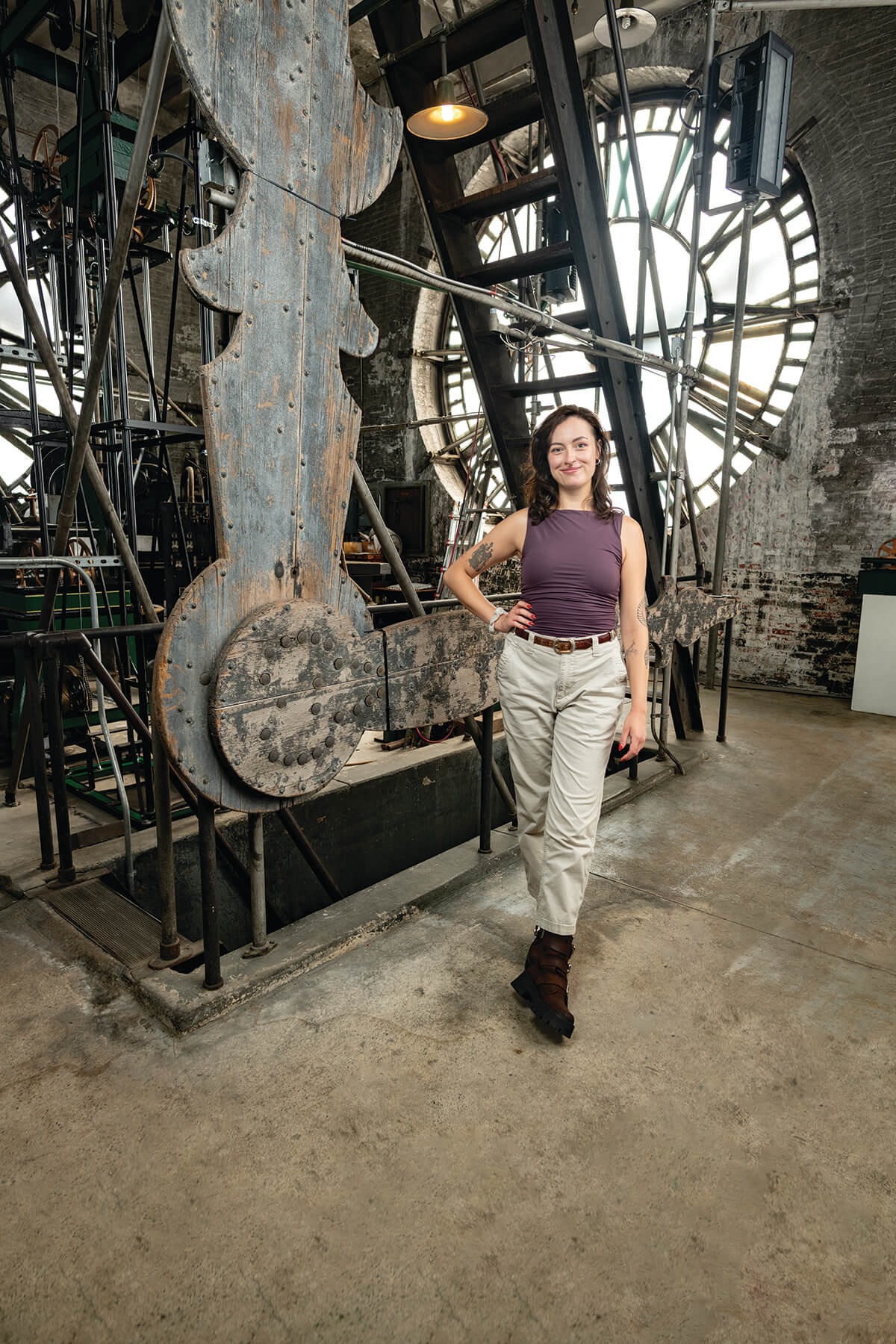Arts & Culture
The Bromo Seltzer Clocktower Ticks On After More Than a Century
One of the world’s few female clock-keepers, Eliza Kurtz takes us inside the downtown landmark.

There are 15 floors in the tiny elevator of the Bromo Seltzer Arts Tower. At the top, visitors exit out into a small atrium, surrounded by a miniature museum, dedicated to the building’s namesake—a now-discontinued headache and heartburn remedy, of all things.
And yet from this landing, on a warm summer morning in early July, Eliza Kurtz is taking us even higher. On the 16th floor, accessible only via the marble staircase, she reaches a narrow hallway where a window in the wood-paneled wall reveals the bottom of a large pendulum, swinging back and forth, back and forth, roughly every other second. Then she gestures toward a set of industrial steps—up one more, to the tower’s main attraction.
“Watch yourself on the ship’s ladder,” says Kurtz, facilities manager for the Baltimore Office of Promotion and the Arts (BOPA), which oversees this city-owned landmark on the corner of Lombard and Eutaw streets—one of the skyline’s most iconic features.
When completed in 1911, the downtown tower was the tallest building in Baltimore, visible for miles and from the ships that entered the city’s bustling harbor. Originally known as the Emerson Tower, it was built by Isaac Edward Emerson, the pharmacist who invented the best-selling antacid, and the owner of the Maryland Glass Corporation, which manufactured the medicine’s blue-glass bottles in a factory on the same corner.
Modeled after the Palazzo Vecchio in Italy, the brick skyscraper was the talk of the town, crowned with a castle-like clocktower, atop which sat an illuminated, revolving, super-sized bottle of Bromo Seltzer. That dazzling advertisement was later removed for safety reasons (like the product itself), but the four-dial timepiece remains, with the story-high hands of each face still ticking around roman numerals and the dozen blue letters that spell out that late brand name today.
“It’s beautiful, isn’t it?” says Kurtz, stepping out onto the 17th floor, where natural light pours into an old workroom from the north, south, east, and west. Warehouse lamps hang from above. Paint fades on century-old beams and brick. And in the center of the room sits the surprisingly compact yet complex clock mechanism, slowly but surely moving time.
It’s a feat of physics, this gravity-driven piece of machinery, powered by a 400-pound stack of weights suspended in the air on a steel cable. Eventually wound back up by an electric motor, they gradually descend throughout the day, turning a set of shiny brass gears. Those engage two pencil-sized pins that keep the downstairs pendulum steadily swinging, which ultimately turns the hours and minutes on the story-high hands outside, visible to passersby from the streets below.
And it’s up to Kurtz to keep it all running. One of the few female clock-keepers in the world, the 28-year-old Monkton native and University of Maryland grad is tasked with routine upkeep, from daily checks to monthly maintenance, which includes dusting surfaces, oiling gears, and resetting the time when necessary. Which is not only twice a year for daylight savings.
“Mechanical timekeeping is notoriously imperfect,” says Kurtz, pointing to a variety of factors that can impact its function, like wind and humidity. “Usually, by the end of the month, it’s at least five minutes off.”
For big fixes, she enlists a restoration company from Maine. Other days, she oversees the rest of the building, helping manage the 25 artist studios located between the fourth and 14th floors, which opened here in 2008, a few years after BOPA took over the building. She also coordinates the gallery exhibitions on the lower levels and lobby, and on Saturdays, leads public tours, hosting both awestruck tourists who’ve spotted the building from a hotel or ball game and longtime locals, some visiting for the very first time. This month, during the biannual Bromo Art Walk on Sept. 11, all floors are open for exploring.
Kurtz remembers touring the tower as a little kid, but never expected to work here. She arrived at BOPA six years ago, knowing next to nothing about horology (aka the science of clock keeping), instead learning along the way.
“These days, the clock gets hidden behind other buildings,” says the 28-year-old, looking like a chic mechanic in her 1940s-inspired workwear and platform combat boots, “but in Baltimore, you grow up seeing it.”
And while no longer the city’s tallest structure, the Bromo tower is still something to marvel at—its dials even being one whole foot larger than those of its better-known cousin, located across the pond in England.
“Take that, Big Ben,” says Kurtz.